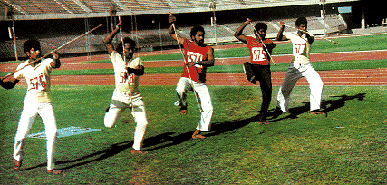| Cheibi Gad-Ga | |
| Kalari Payattu | |
| Silambam | |
| Thang-ta | |
| Thoda | |
| Silambam
The state of Tamil Nadu is considered to be the cradle of modern and scientific staff fencing, popularly known in Tamil as Silambam. The Pandya kings ruling in Tamil Nadu promoted Silambam fencing, as did their Chola and Chera counterparts. Silapathiharam Tamil literature, dating back to 2nd century A.D., refers to the sale of silamabam staves, swords, pearls and armour to foreign traders. The ancient trading centre at Madurai city, renowned globally, was said to be thronged by Romans, Greeks, Egyptians among others who had regular sea trade with the ancient Dravidian kings. The silambam staff was one of the martial art weapons, that was in great demand with the visitors. The use of the long staff for self - defence or mock - fighting was a highly organised game in the state as early as the 1st and 2nd centuries A.D. In the Vedic age, young men were imparted training to defend themselves with staves, both as a ritual and an emergency. The staves wielded by ace fencers were given distinctive names, and treated with reverence. Some records trace the origin of this art to a divine source - Lord Muruga, and within the Tamil mythological framework, sage Agasthya is also credited with the genesis of Silambam. Silambam is believed to have travelled from Tamil Nadu to Malaysia, where it is now a popular recreational sport and also a mode of self - defence. Four different types of staves are used in this activity. One produces a sonorous, swishing sound, another involves lighted balls of cloth at one end of the staves, called 'torch silambam', a third is quite short in length nevertheless powerful, and finally a non - elastic staff that produces a clattering sound. Today this rather simplistic art form is a mode of self defence used by the common folk of Tamil Nadu. Techniques Silambam incorporates a range of techniques.
The player must also be able to ward off stones hurled by a crowd, and disperse an unruly mob by a range of strokes like 'monkey hits', 'snake hits', 'hawk hits' and 'spring hits', which must be inflicted in quick succession. This activity involves some amazing footwork, staff - swinging, pivot - jumping and stroke play. From a purely defensive art, Silambam has become a combat exercise. Silambam is a three - type contest. a) A fight to the finish, when one of the players is dispossessed of his staff. b) Total number of ' touches ' one combatant makes on the other ( indicated by appropriate markings on the body ). c) Skill shown in protecting a pouch of money ( kept at or in between a contestant's feet ). The contestant succeeding in leaving a mark on the forehead of his opponent is adjudged as the victor in the contest. Dress The contestants wear langots of various colours, sleeveless vests, turbans, canvas shoes, and a chest guard which is a part of the traditional attire of Palmyrah tree - climbers. Wicker - work shields also form an essential part of the gear. The Contest The contest begins with salutations to God, the competitor, the audience and the guru. The result is determined on the basis of the number of touches made by one contestant on another. To distinguish these touches, the ends of the staves are coated with a sticky powder that leaves behind a mark . The mark generally counts as one point, but in certain areas, a touch above the waist counts as two points, while those made below get only one point. In certain areas, the winner is one who makes a mark on his opponent's back, while in others, the contestant who makes the first three touches on the other's body wins. The contest comes to a close, after a period of time fixed well in advance of the contest, or when one of the contestants is dispossessed of his staff. Silambam is fought on an even and hard surface, but never on a sandy or slippery area. The arena of this activity is usually circular, the radius not less than 20 ft and not more than 25 ft, when only two contestants are involved. The duration ranges from 6 to 10 minutes, which is divided into four equal quarters. An interval of one minute is allowed at the end of the first and third quarters, while at the end of the second quarter an interval of 3 minutes is allowed. |
